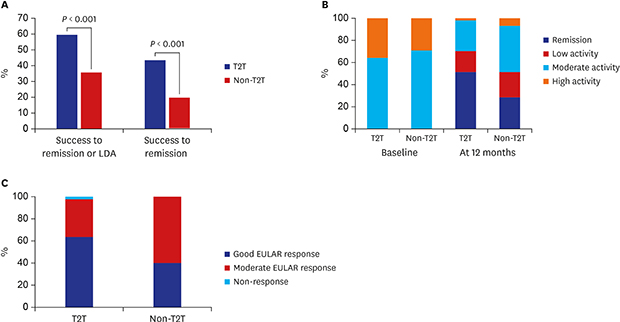1. Scott DL, Wolfe F, Huizinga TW. Rheumatoid arthritis. Lancet. 2010; 376(9746):1094–1108.

2. Smolen JS, Aletaha D, Bijlsma JW, Breedveld FC, Boumpas D, Burmester G, et al. Treating rheumatoid arthritis to target: recommendations of an international task force. Ann Rheum Dis. 2010; 69(4):631–637.

3. Smolen JS, Breedveld FC, Burmester GR, Bykerk V, Dougados M, Emery P, et al. Treating rheumatoid arthritis to target: 2014 update of the recommendations of an international task force. Ann Rheum Dis. 2016; 75(1):3–15.
4. Schoels M, Knevel R, Aletaha D, Bijlsma JW, Breedveld FC, Boumpas DT, et al. Evidence for treating rheumatoid arthritis to target: results of a systematic literature search. Ann Rheum Dis. 2010; 69(4):638–643.

5. Haraoui B, Smolen JS, Aletaha D, Breedveld FC, Burmester G, Codreanu C, et al. Treating rheumatoid arthritis to target: multinational recommendations assessment questionnaire. Ann Rheum Dis. 2011; 70(11):1999–2002.

6. Park YB, Koh EM, Kim HY, Park SH, Park W, Bae SC, et al. Treating rheumatoid arthritis to target: recommendations assessment questionnaire in Korea. Clin Rheumatol. 2013; 32(12):1791–1797.

7. Arnett FC, Edworthy SM, Bloch DA, McShane DJ, Fries JF, Cooper NS, et al. The American Rheumatism Association 1987 revised criteria for the classification of rheumatoid arthritis. Arthritis Rheum. 1988; 31(3):315–324.

8. Harrold LR, Reed GW, Harrington JT, Barr CJ, Saunders KC, Gibofsky A, et al. The rheumatoid arthritis treat-to-target trial: a cluster randomized trial within the Corrona rheumatology network. BMC Musculoskelet Disord. 2014; 15:389.

9. Fransen J, van Riel PL. Outcome measures in inflammatory rheumatic diseases. Arthritis Res Ther. 2009; 11(5):244.

10. Lee HS, Oh KT, Kim TH, Jung S, Yoo DH, Bae SC. A Korean rheumatic diseases screening questionnaire. J Korean Med Sci. 2003; 18(2):171–178.

11. Lee JH, Kim SI. Epidemiology and diagnosis of rheumatoid arthritis. Hanyang Med Rev. 2005; 25:4–12.
12. Statistics Korea. 2010 Population and Housing Census Report. Daejeon, Korea: Statistics Korea;2011.
13. Hur NW, Choi CB, Uhm WS, Bae SC. The prevalence and trend of arthritis in Korea: results from the Korea National Health and Nutrition Examination Surveys. J Korean Rheum Assoc. 2008; 15(1):11–26.
14. Solomon DH, Bitton A, Katz JN, Radner H, Brown EM, Fraenkel L. Review: treat to target in rheumatoid arthritis: fact, fiction, or hypothesis? Arthritis Rheumatol. 2014; 66(4):775–782.

15. Jurgens MS, Welsing PM, Jacobs JW. Overview and analysis of treat-to-target trials in rheumatoid arthritis reporting on remission. Clin Exp Rheumatol. 2012; 30(4):Suppl 73. S56–S63.
16. Kwok KY, Leung MH. Tight control early rheumatoid arthritis clinic in Hong Kong: a pilot study. Hong Kong Med J. 2012; 18(2):108–114.
17. Song YJ. The South Korean health care system. Japan Med Assoc J. 2009; 52:206–209.
18. Sung YK, Cho SK, Kim D, Yoon BY, Choi CB, Cha HS, et al. Factors contributing to discordance between the 2011 ACR/EULAR criteria and physician clinical judgment for the identification of remission in patients with rheumatoid arthritis. J Korean Med Sci. 2016; 31(12):1907–1913.

19. Hetland ML, Krogh NS, Hørslev-Petersen K, Schiøttz-Christensen B, Sørensen IJ, Dorte Vendelbo J. Using an electronic platform interactively to improve treatment outcome in patients with rheumatoid arthritis: new developments from the DANBIO registry. Clin Exp Rheumatol. 2016; 34(5):Suppl 101. S75–S78.
20. Suh YS, Cheon YH, Kim HO, Kim RB, Park KS, Kim SH, et al. Medication nonadherence in Korean patients with rheumatoid arthritis: the importance of belief about medication and illness perception. Korean J Intern Med. 2018; 33(1):203–210.
21. Kobelt G, Jönsson L, Lindgren P, Young A, Eberhardt K. Modeling the progression of rheumatoid arthritis: a two-country model to estimate costs and consequences of rheumatoid arthritis. Arthritis Rheum. 2002; 46(9):2310–2319.

22. Vermeer M, Kievit W, Kuper HH, Braakman-Jansen LM, Bernelot Moens HJ, Zijlstra TR, et al. Treating to the target of remission in early rheumatoid arthritis is cost-effective: results of the DREAM registry. BMC Musculoskelet Disord. 2013; 14:350.

23. Kim D, Choi CB, Lee J, Cho SK, Won S, Bang SY, et al. Impact of early diagnosis on functional disability in rheumatoid arthritis. Korean J Intern Med. 2017; 32(4):738–746.

24. Kim HY, Song YW. The dynamic evolution of rheumatology in Korea. Nat Rev Rheumatol. 2016; 12(3):183–189.

25. Grigor C, Capell H, Stirling A, McMahon AD, Lock P, Vallance R, et al. Effect of a treatment strategy of tight control for rheumatoid arthritis (the TICORA study): a single-blind randomised controlled trial. Lancet. 2004; 364(9430):263–269.

26. Goekoop-Ruiterman YP, de Vries-Bouwstra JK, Kerstens PJ, Nielen MM, Vos K, van Schaardenburg D, et al. DAS-driven therapy versus routine care in patients with recent-onset active rheumatoid arthritis. Ann Rheum Dis. 2010; 69(1):65–69.

27. Soubrier M, Lukas C, Sibilia J, Fautrel B, Roux F, Gossec L, et al. Disease activity score-driven therapy versus routine care in patients with recent-onset active rheumatoid arthritis: data from the GUEPARD trial and ESPOIR cohort. Ann Rheum Dis. 2011; 70(4):611–615.

28. Schipper LG, Vermeer M, Kuper HH, Hoekstra MO, Haagsma CJ, Den Broeder AA, et al. A tight control treatment strategy aiming for remission in early rheumatoid arthritis is more effective than usual care treatment in daily clinical practice: a study of two cohorts in the Dutch Rheumatoid Arthritis Monitoring registry. Ann Rheum Dis. 2012; 71(6):845–850.











 PDF
PDF Citation
Citation Print
Print




 XML Download
XML Download